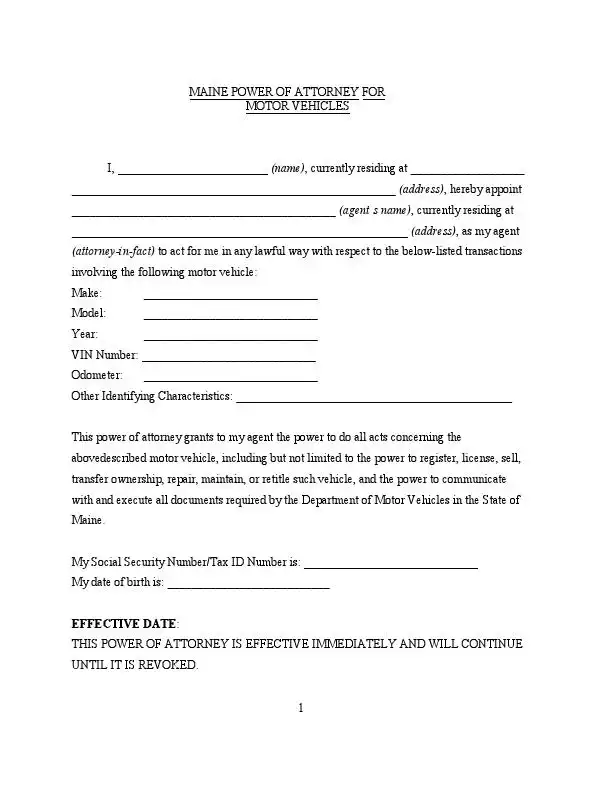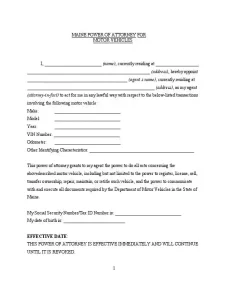Maine Motor Vehicle Power of Attorney Form
The Maine motor vehicle power of attorney allows a person, known as the principal, to designate another person, called the agent or attorney-in-fact, to make decisions and act on their motor vehicle affairs. This legal instrument is useful for handling registration, titling, and sale transactions when the car owner is absent.

Build Your Document
Answer a few simple questions to make your document in minutes
Save and Print
Save progress and finish on any device, download and print anytime
Sign and Use
Your valid, lawyer-approved document is ready
Title 18-C, Article 5, Part 9 of the Maine Revised Statutes, known as the Maine Uniform Power of Attorney Act, outlines the legal framework for creating and using POA within the state. The powers granted through the power of attorney forms in Maine are subject to certain limitations and conditions:
- The agent’s power is strictly limited to the tasks mentioned in the POA document.
- If any, the POA remains effective until the expiration date specified within the document. Without a specified end date, it continues until revoked.
- The principal can revoke the power of attorney at any time, provided they do this in writing and inform all relevant parties, including the agent and the Maine Bureau of Motor Vehicles.
Complying with these requirements is necessary for the power of attorney to be accepted by the Maine Bureau of Motor Vehicles and other agencies. Furthermore, using Maine POA forms requires careful consideration to ensure that the agent acts within the bounds of the authority granted.
Maine Motor Vehicle Power of Attorney Form Details
| Document Name | Maine Motor Vehicle Power of Attorney Form |
| State Form Name | None |
| Relevant Link | Maine Bureau of Motor Vehicles |
| Avg. Time to Fill Out | 15 minutes |
| # of Fillable Fields | 25 |
| Available Formats | Adobe PDF |
Filling Out Maine Vehicle POA
Completing the Maine motor vehicle POA with precision ensures that your vehicle-related affairs will be managed according to your wishes, even in your absence. Always keep a copy of the notarized power of attorney for your records.
1. Enter the Principal’s Information
Begin by entering your full legal name and current residence. This field identifies you as the principal — the person granting the power of attorney. It is important to use the address where you live, as this information may be used for verification or contact purposes.
2. Designate Your Agent
Specify the full name and address of the person you appoint as your agent. This is the person who will act on your behalf. Discuss this responsibility with them beforehand to ensure they can complete the specified tasks.
3. Describe the Vehicle
Provide detailed information about the vehicle involved in the POA. This includes the make, model, year, Vehicle Identification Number (VIN), and odometer reading. If there are any other identifying characteristics of the vehicle that might be relevant (such as special modifications or a unique license plate), include those as well.
4. Specify Powers Granted
Clearly outline the powers you are granting to your agent. These can include the authority to register, license, sell, transfer ownership, repair, maintain, or retitle the vehicle. Be specific about what your agent can do to avoid any confusion or legal issues.
5. Include Personal Identifiers
Fill in your Social Security Number or Tax ID Number and date of birth. These identifiers are necessary for the validation of the document and to comply with legal requirements.
6. Sign and Date the Form
After reviewing all the information and ensuring its accuracy, sign the form. Include the date of signing to establish when the POA goes into effect. This act formalizes the document, making it legally binding.
7. Notarization
Take the document to a notary public. The notary will verify your identity, witness your signature, and seal the document. This step is mandatory as it validates the authenticity of the POA.
8. Provide Copies to Necessary Parties
Once notarized, provide copies of the POA to your agent and any relevant third parties, such as the Maine Bureau of Motor Vehicles or a car dealership. Keeping everyone informed ensures the POA is recognized and can be acted upon immediately.
